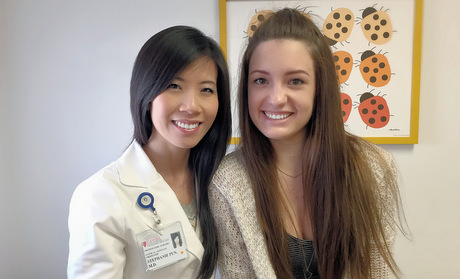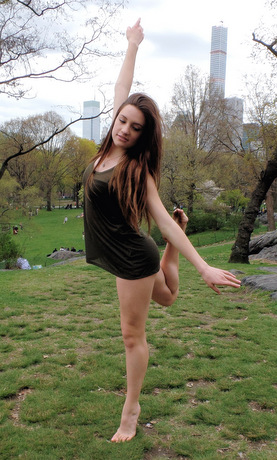Sonoma Teen Dancer Realizes Joffrey Dream, Thanks to Hip Preservation Specialists at Stanford Medicine Children’s Health and California Pacific Medical Center
* In a wheelchair last fall, Anika Ljung just finished her first term in NYC, where she danced eight hours a day
* Team treats complex hip deformities in children, adolescents and young adults
For Release: June 08, 2015
SAN FRANCISCO, Calif. – Being accepted to the Joffrey Ballet School’s contemporary dance program is an honor that few dancers are given; add the complications of scoliosis and hip dysplasia, and landing a spot at the prestigious New York City program would seem like an impossible dream. But that hasn’t stopped 17-year-old Anika Ljung, who has been treated for both conditions through Stanford Medicine Children’s Health at California Pacific Medical Center.

Anika says she didn’t expect to be asked to join Joffrey when she auditioned in January, 2014. She was a sophomore at Sonoma Valley High School and mostly trying out for the experience. Two weeks later, an acceptance letter offered her one of the 90 highly coveted spots in the academy’s fall program for young, contemporary dancers. As she jumped for joy, she had no idea that hip dysplasia would get in the way of the dream.
The trouble appeared four months later. Anika’s hip, which had been troubling her on and off for years, felt like it “popped out” and the front of her hip began hurting. Earlier, at 14, Anika had been diagnosed with the dysplasia, or shallow hip socket, and occasionally, her leg and hip would feel unstable, as if they had separated from each other. Usually, medication, physical therapy and ice were enough to alleviate her symptoms. But this time, her pain progressed and prevented her from walking and dancing.
That’s when Anika made an appointment at CPMC to see orthopedic surgeon Stephanie Pun, MD, director of the hip preservation program at Lucile Packard Children’s Hospital Stanford and Stanford Medicine Children’s Health. Pun is also clinical assistant professor of orthopedic surgery at the Stanford University School of Medicine.
“This type of teamwork between CPMC and Stanford Medicine Children’s Health allows us to provide a tremendous service for San Francisco and North Bay families like Anika’s,” said Lorry Frankel, MD, CPMC chair of pediatric specialties. “It means kids and young adults can access highly specialized specialty care without extended travel.” The pediatric orthopedic programs at CPMC have been a major part of the collaboration.
The solution for Anika? Surgery. Although it was the news Anika didn’t want to hear, she and her parents were comforted by Pun’s detailed explanation and thorough answers to all of their questions. Anika’s determination quickly surfaced, and she immediately told her mom, Angela, “I’m going to Joffrey no matter what.”
Pun explained Anika’s situation. “The hip is a ball-and-socket joint. When you have a socket that is too shallow and doesn’t cover the ball enough, the hip is unstable, especially when participating in physically demanding activities,” said Pun. “Over time, instability of the hip causes damage to the labrum and cartilage lining of the joint, which can result in pain and hip arthritis.”
It was just the latest chapter in a story of grit and perseverance. Anika had been diagnosed with scoliosis – curvature of the spine – at age 8. For five years, 20 hours a day, she wore a hard, plastic back brace from just under her armpit to below her tailbone. Allowed to take the brace off for only four hours a day, Anika would use that reprieve to take a shower and participate in PE at school. But mostly, when not in her brace, she would dance. And dance.
“She started when she was 3 years old,’’ said Angela. “She says dancing is like breathing. It’s just what she does.”
Dancing did not cause Anika’s dysplasia, but it may have hastened its effect on her body. Anika has several risk factors associated with the genetic disorder, including family history and breech birth. It is also more frequently found in girls than boys, and occurs in 1 of every 1,000 people. If it goes undetected in early childhood, as it did in Anika, it often appears in teens and young adults who are physically active.
During a three-hour surgery last August, Pun performed a periacetabular osteotomy (PAO) on Anika. To improve the stability of Anika’s hip, Pun freed the acetabulum (socket) from the rest of the pelvis and repositioned it to properly cover the femoral head (ball). The acetabulum was then held in its new position by several screws, which would remain until the bony cuts healed several months later.
Pun says the PAO surgery provides a permanent fix for hip dysplasia. The surgery improves hip function, decreases hip pain, stops the damage occurring inside of the joint, prevents hip arthritis and the need for a hip replacement, and will allow Anika to dance for years to come.

Indeed, the successful surgery meant Anika could still go to Joffrey, but at a slightly later date. Instead of starting the academy last September, she joined this past January.
Recovery after surgery was challenging. Anika attended high school in a wheelchair and used crutches at home. “I couldn’t even lift my leg off of the floor,’’ Anika said of the days following her operation. “I worked every single day to gain my strength back.”
Two months after surgery, Anika was walking without crutches, and by early January, just two weeks before she was to board a plane to New York, she began dancing regularly again. She is now dancing five days a week, 9 to 5, and Saturdays and Sundays are usually filled with six-hour rehearsals. School is done online at night.
“I can’t imagine life without dancing because I don’t even remember life without it,” said Anika, who expressed thanks for Pun’s advanced surgical intervention. “I never thought that given my condition and the surgery that I would come out of it as strong as I am today, but Dr. Pun was really invested in my recovery. She is an amazing doctor.”
About Stanford Medicine Children's Health
Stanford Medicine Children’s Health, with Lucile Packard Children’s Hospital Stanford at its center, is the Bay Area’s largest health care system exclusively dedicated to children and expectant mothers. Our network of care includes more than 65 locations across Northern California and more than 85 locations in the U.S. Western region. Along with Stanford Health Care and the Stanford School of Medicine, we are part of Stanford Medicine, an ecosystem harnessing the potential of biomedicine through collaborative research, education, and clinical care to improve health outcomes around the world. We are a nonprofit organization committed to supporting the community through meaningful outreach programs and services and providing necessary medical care to families, regardless of their ability to pay. Discover more at stanfordchildrens.org.
Connect with us:
Download our App: